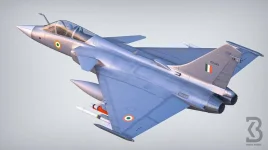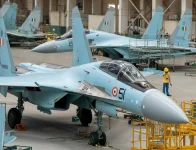- Views: 2K
- Replies: 14
As India advances its flagship fifth-generation fighter program, the Advanced Medium Combat Aircraft (AMCA), a strategic debate is emerging over its future direction.
A proposal to develop a variant using powerful Russian AL-51F/177S engines is gaining attention, suggesting a path for transforming the aircraft into a heavier, more capable stealth fighter.
While this approach could provide a powerful backup to the current plan and counter regional threats, it also presents significant technical and financial hurdles.
The AMCA is being developed by the Aeronautical Development Agency (ADA) as a 25-tonne class, twin-engine stealth aircraft to form the future backbone of the Indian Air Force (IAF) and Navy.
The current roadmap, approved by the Cabinet Committee on Security with a budget of approximately ₹15,000 crore for initial development, involves two phases.
The initial AMCA Mk1 version will be powered by American General Electric F414 engines. The more advanced Mk2 is slated to use a more powerful 110-kilonewton (kN) engine, to be developed indigenously in collaboration with a foreign partner, likely France's Safran. Mass production is currently projected to begin after 2035.
The alternative concept involves integrating Russia's AL-51F/177S engine, currently in development for aircraft like the Su-57. This engine, a product of Russia's United Engine Corporation, reportedly offers a substantial thrust of around 142 kN.
Proponents argue that incorporating this powerhouse engine could allow India to develop a heavier AMCA variant. Such an aircraft would possess superior speed, agility, and a larger weapons payload, effectively creating a heavy multirole fighter to complement the standard AMCA.
This becomes strategically important as India seeks to maintain air superiority in a region where China operates its J-20 stealth fighter and may supply the similar J-35 to Pakistan.
Strategic and Operational Benefits
A parallel development using Russian engines could offer several advantages.Firstly, it would act as a strategic safeguard against potential delays in the indigenous engine program. The history of India’s Kaveri engine project, which faced a prolonged and challenging development cycle, underscores the risks of relying on a single, yet-to-be-developed propulsion system. The Russian engine offers a proven, high-thrust alternative that could ensure the program's momentum.
Secondly, the significantly higher thrust of the AL-51F/177S could enable the creation of a platform dedicated to deep-strike and air dominance missions. A heavier airframe could carry a much larger payload, increasing its internal and external weapons capacity well beyond the current design. This would provide the IAF with a modern replacement for its aging fleets of Mirage 2000, Jaguar, and MiG-29 aircraft, filling a critical gap for a high-performance fighter jet.
Finally, this approach could create industrial and technological synergies. Collaborating with Russia on the advanced engine, which features systems like Full Authority Digital Engine Control (FADEC), could provide valuable technology transfer.
Furthermore, if India also proceeds with the "Super Sukhoi" upgrade for its large Su-30MKI fleet, using a similar family of engines for both programs could create efficiencies in manufacturing, maintenance, and supply chains.
Significant Hurdles and Considerations
Despite the potential, this path is fraught with challenges. The AMCA's airframe and its critical stealth features, such as the diverterless supersonic intakes (DSI), have been meticulously designed around the dimensions and thrust of the GE F414 and the planned 110 kN engine.Integrating a larger and more powerful Russian engine would not be a simple swap; it would demand a substantial redesign of the aircraft's structure. Experts estimate such a redesign could set the program back by four to five years, negating many of the benefits.
The financial implications are also considerable. Developing a separate variant would require massive additional funding beyond the already allocated budget. This could strain the nation's defence resources and potentially divert funds from other critical modernisation projects, such as the Tejas Mk2 and the Twin Engine Deck Based Fighter (TEDBF) for the Navy.
Furthermore, committing to a Russian engine raises geopolitical questions. India's current policy of Aatmanirbhar Bharat emphasizes indigenous development and diversified partnerships with Western nations.
Over-reliance on Russian technology could create long-term vulnerabilities in the supply chain, particularly in a shifting global political landscape. This move would run counter to the strengthening strategic partnerships with the United States and France on the primary AMCA program.
Ultimately, while the prospect of a heavier, more powerful AMCA is compelling, the practical realities suggest a more cautious approach. The technical, financial, and strategic obstacles are immense.
A more pragmatic path may be to focus all resources on accelerating the indigenous engine development with Safran, while perhaps exploring the Russian engine solely for the Su-30MKI upgrade, thereby securing India's ambitious fifth-generation fighter program without risking its timeline and strategic focus.


